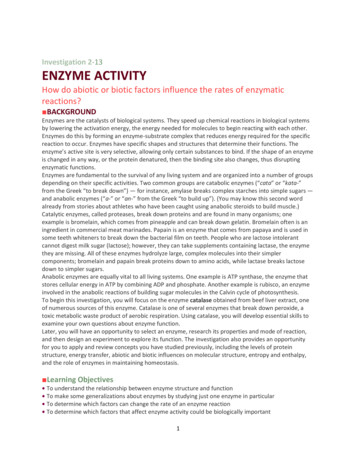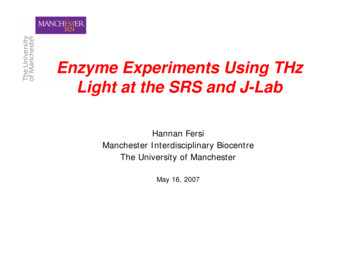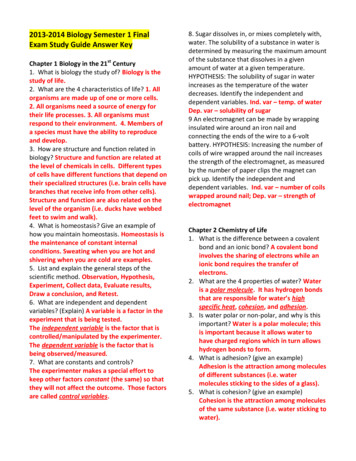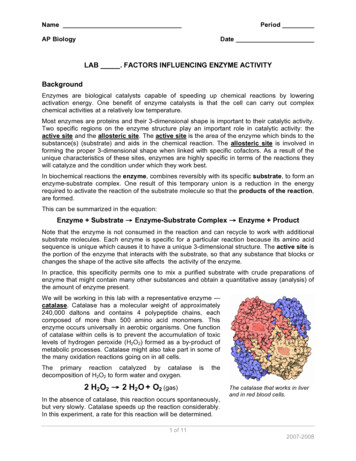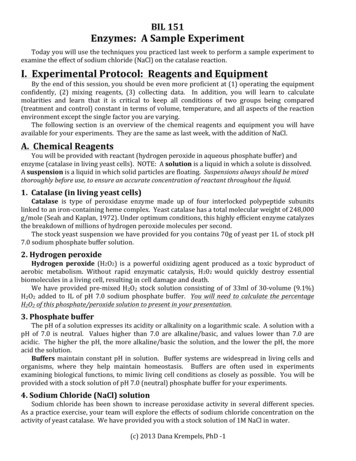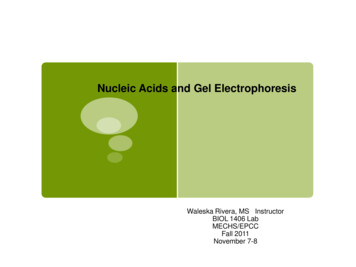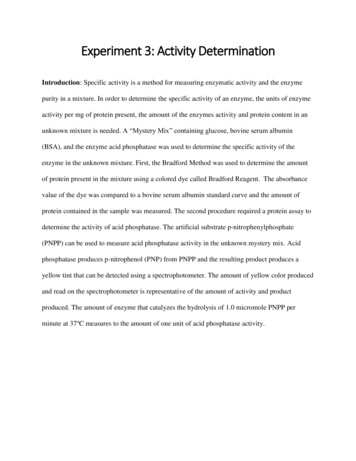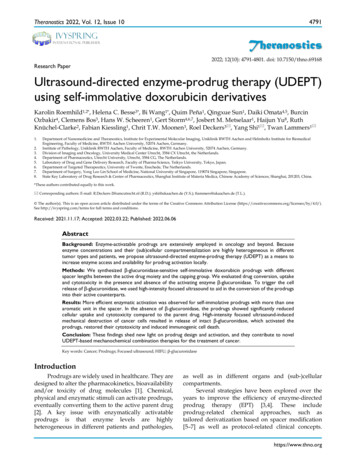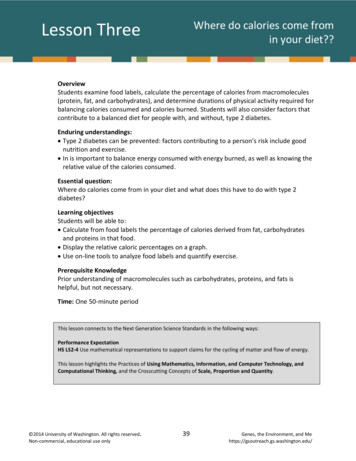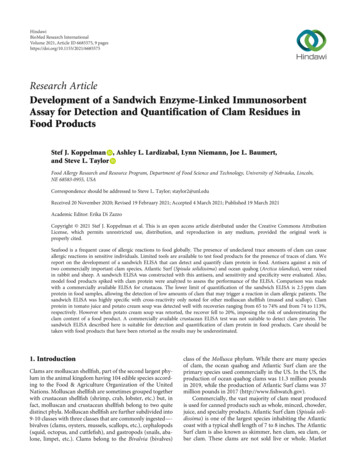
Transcription
HindawiBioMed Research InternationalVolume 2021, Article ID 6685575, 9 pageshttps://doi.org/10.1155/2021/6685575Research ArticleDevelopment of a Sandwich Enzyme-Linked ImmunosorbentAssay for Detection and Quantification of Clam Residues inFood ProductsStef J. Koppelman , Ashley L. Lardizabal, Lynn Niemann, Joe L. Baumert,and Steve L. TaylorFood Allergy Research and Resource Program, Department of Food Science and Technology, University of Nebraska, Lincoln,NE 68583-0955, USACorrespondence should be addressed to Steve L. Taylor; staylor2@unl.eduReceived 20 November 2020; Revised 19 February 2021; Accepted 4 March 2021; Published 19 March 2021Academic Editor: Erika Di ZazzoCopyright 2021 Stef J. Koppelman et al. This is an open access article distributed under the Creative Commons AttributionLicense, which permits unrestricted use, distribution, and reproduction in any medium, provided the original work isproperly cited.Seafood is a frequent cause of allergic reactions to food globally. The presence of undeclared trace amounts of clam can causeallergic reactions in sensitive individuals. Limited tools are available to test food products for the presence of traces of clam. Wereport on the development of a sandwich ELISA that can detect and quantify clam protein in food. Antisera against a mix oftwo commercially important clam species, Atlantic Surf (Spisula solidissima) and ocean quahog (Arctica islandica), were raisedin rabbit and sheep. A sandwich ELISA was constructed with this antisera, and sensitivity and specificity were evaluated. Also,model food products spiked with clam protein were analyzed to assess the performance of the ELISA. Comparison was madewith a commercially available ELISA for crustacea. The lower limit of quantification of the sandwich ELISA is 2.5 ppm clamprotein in food samples, allowing the detection of low amounts of clam that may trigger a reaction in clam allergic patients. Thesandwich ELISA was highly specific with cross-reactivity only noted for other molluscan shellfish (mussel and scallop). Clamprotein in tomato juice and potato cream soup was detected well with recoveries ranging from 65 to 74% and from 74 to 113%,respectively. However when potato cream soup was retorted, the recover fell to 20%, imposing the risk of underestimating theclam content of a food product. A commercially available crustacean ELISA test was not suitable to detect clam protein. Thesandwich ELISA described here is suitable for detection and quantification of clam protein in food products. Care should betaken with food products that have been retorted as the results may be underestimated.1. IntroductionClams are molluscan shellfish, part of the second largest phylum in the animal kingdom having 104 edible species according to the Food & Agriculture Organization of the UnitedNations. Molluscan shellfish are sometimes grouped togetherwith crustacean shellfish (shrimp, crab, lobster, etc.) but, infact, molluscan and crustacean shellfish belong to two quitedistinct phyla. Molluscan shellfish are further subdivided into9-10 classes with three classes that are commonly ingested—bivalves (clams, oysters, mussels, scallops, etc.), cephalopods(squid, octopus, and cuttlefish), and gastropods (snails, abalone, limpet, etc.). Clams belong to the Bivalvia (bivalves)class of the Mollusca phylum. While there are many speciesof clam, the ocean quahog and Atlantic Surf clam are theprimary species used commercially in the US. In the US, theproduction of ocean quahog clams was 11.3 million poundsin 2019, while the production of Atlantic Surf clams was 37million pounds in 2017 (http://www.fishwatch.gov).Commercially, the vast majority of clam meat producedis used for canned products such as whole, minced, chowder,juice, and specialty products. Atlantic Surf clam (Spisula solidissima) is one of the largest species inhabiting the Atlanticcoast with a typical shell length of 7 to 8 inches. The AtlanticSurf clam is also known as skimmer, hen clam, sea clam, orbar clam. These clams are not sold live or whole. Market
2forms of surf clams include chopped, frozen, individuallyquick frozen (IQF), or canned including prefried strips,breaded, chowders, bisques, and clam juice (http://www.fishwatch.gov). The surf clam is the only clam that is usedin manufacturing frozen, breaded clam strips. The shuckedmeat of the surf clam includes the “tongue” which is oftenused to make fried clam strips and the strap meat which isground or chopped and used for chowders, bisques, andsauces. The ocean quahog (Arctica islandica) is somewhatsmaller (2.8 to 4.3 inches in shell length) and is marketedfor in-shell preparation as well. This clam is known by a variety of names including mahogany clam, mahogany quahog,ocean clam, or black clam. Ocean quahog meat is stronglyflavored and is often used in products that are complementedby this taste, such as tomato-based recipes. These clams aregenerally minced, chopped, or cut into strips before theyare suitable for the table. The Northern quahog or hard clam(Mercenaria mercenaria) is another commercial species inthe US but annual production of Northern quahog is substantially lower than that of ocean quahog and Atlantic Surfclam (http://www.fishwatch.gov).Both molluscan and crustacean shellfish are well-knowncauses of IgE-mediated, immediate hypersensitivity allergicreactions [1, 2]. Crustacean shellfish allergies are perhapsthe most prevalent food allergy globally with estimates fromself-report surveys in the US as high as 2% [3–6]. When clinical confirmation is sought, the prevalence rate drops to lessthan half of these estimates [7]. The prevalence of molluscanshellfish allergy has not been thoroughly assessed. Self-reportsurveys in the US indicated that the prevalence of molluscanshellfish allergy is between 0.4% and 0.5% [5, 6]. Aquestionnaire-based survey of 2716 school children in Franceestimated that the prevalence of molluscan shellfish allergywas 0.15% [8]. However, none of the allergies reported inFrance involved clams. In a survey of patients with food allergies from 17 clinics in 15 cities in the Baltic region of the EU,6.2% of the participants indicated an allergy to clams [9].However, clinical confirmation of these survey responseswas not conducted. In several studies of food-allergic patientsat separate clinics in Spain, 10/355 (2.8%) and 10/120 (8.3%),respectively, reported allergies to clams without furtherclinical confirmation [10, 11]. Skin testing of 625 Japaneseasthmatic adults showed that 6.9% were sensitized to a clamextract but again food challenges were not conducted to confirm reactivity to clam [12]. In a nationwide survey of 30,018individuals in Taiwan, 1.2% reported allergies to molluscanshellfish [13] but clinical confirmation was not sought.The clinical literature contains very few well-documentedcase reports of IgE-mediated clam allergy. Clam allergy wasfirst reported as early as 1916 [14, 15]. Parker et al. [16]described two clam allergic patients; one had gastrointestinalsymptoms on oral challenge while the other had a history oflaryngeal edema and was not challenged. Jiménez et al. [17]described an adult woman who experienced pruritis and facialangioedema on three occasions after eating razor clams. Inaddition, clams have been implicated in several cases of foodprotein-induced enterocolitis syndrome or FPIES [18, 19].Individuals with shellfish allergies (either molluscan orcrustacean or both) often avoid consumption of all shellfishBioMed Research Internationalspecies. Considerable biological diversity occurs within themolluscan phylum, and even more diversity exists betweenthe molluscan and crustacean phyla so the likelihood ofcross-reactivity among the many species within the molluscan phylum or across the molluscan and crustacean phylaseems unlikely, although some individuals do have crosssensitivity to both molluscan and crustacean species [2].The muscle protein, tropomyosin, seems to be a major allergenic protein in both molluscan and crustacean species [20,21] but sequence homology between molluscan and crustacean species is sufficiently different that cross-reactivity isnot common [2, 22]. The allergens in clam have not beenwidely studied but tropomyosin is identified as an allergenin four clam species: short-neck clam (Ruditapes philippinarum), Sakhalin surf clam (Spisula sachalinensis), razorclam (Solen strictus), and horse clam (Tresus keenae) [20].Furthermore, cross-reactivity within the bivalve class hasnot been clinically investigated.Avoidance of clam ingestion is the main preventivemeasure taken by clam-allergic consumers. Because of theuse of shared processing facilities and equipment in the foodindustry, a risk exists of cross contact of clam with otherfood products occurring in certain situations. Cross contactcan lead to unintended allergen presence in other foodproducts which could pose a risk to clam-allergic consumers. The proper labeling of packaged foods is criticalto the implementation of a successful clam avoidance diet.Therefore, reliable detection and quantification methodsfor food allergens are needed in order to guarantee compliance with food labeling regulations, to validate the effectiveness of allergen control measures in shared use facilities, andto improve consumer protection. Enzyme-linked immunosorbent assay (ELISA) is currently successfully used foranalysis of other food allergens like milk, egg, walnut, andpeanut [23–27]. We report the development of a sensitiveand specific ELISA for the detection of clam residues infoods, based on the use of polyclonal antisera raised againsta mixture of processed clam proteins.2. Materials and Methods2.1. Immunogen Preparation. Ocean quahog (Arctica islandica) and Atlantic Surf clam (Spisula solidissima) were usedfor the immunogen preparation. Clams were purchasedfrom J. H. Miles Seafood Company (VA) and Blount Seafood Company (MA). The raw, thawed, and chopped clammeat obtained from the suppliers was thoroughly washed3 times with distilled water. The meats were ground separately using a commercial food processor (KPF600 FoodProcessor, Kitchen Aid , St. Joseph, MO). The cooked clamswere prepared by mixing raw clam meat from each speciesin a 1 : 5 (w/v) ratio in deionized water and boiling for 3-5minutes. Equal portions of each clam species were mixed,packed in hermetically sealed containers in water, and thermally processed in a static retort for 70 minutes at 250 Fand 15 psi. Using the Kjeldahl method, the crude proteinof this processed clam was determined and diluted withwater to obtain a 2 mg/mL concentration of protein foruse as the immunogen.
BioMed Research International2.2. Polyclonal Antibody Production and Titer Determination.Polyclonal antibodies were produced at Covance ResearchProducts (Denver, PA). The processed clam immunogenwas used to immunize three New Zealand white rabbits andone sheep. The processed clam protein was emulsified withComplete Freund’s Adjuvant (CFA) and administered tothe rabbits intradermally and to the sheep subcutaneously.Every 21 days thereafter, booster injections were applied subcutaneously with the protein emulsified with IncompleteFreund’s Adjuvant (IFA). Two weeks after each boosterinjection, a serum sample was collected for titer testing. Titervalues of collected antisera were determined by a noncompetitive ELISA method in which log dilutions of serum wereapplied to plates coated with 1 μg of processed clam proteinper well in a coating buffer (15 mM Na2CO3, 35 mMNaHCO3, and 0.02% NaN3, pH 9.6) at 100 μL per well, aspreviously described [24]. The titer values of the antiserawere calculated using the Prism Windows-based computersoftware (GraphPad Software Inc., San Diego, CA) to determine the dilution of antibody at the midpoint of the linearportion of the dilution curve. Sera with titers of 10,000 andhigher were kept and pooled per species. Titers performedon sera obtained from animals prior to immunizationindicated that none of the animals possessed preexisting antibodies to clam.Polyclonal antibodies were partially purified from thesera by precipitation with ammonium sulfate [28]. The partially purified IgG was dialyzed against deionized water andthen extensively dialyzed against 10 mM phosphate bufferedsaline (PBS; 2 mM NaH2PO4, 8 mM Na2HPO4, 0.85% NaCl,and 0.02% NaN3, pH 7:4) [23]. The dialyzed antibodieswere then aliquoted and stored frozen at -20 C.2.3. Clam Standards. The protein content of the processed/canned clam immunogen extracts prepared asdescribed earlier was determined by the Lowry method[29]. Standard clam solutions were prepared using the clamimmunogen extracts diluted in PBS at different levels of clamprotein (1,000, 500, 250, 100, 50, 25, 12.5, 6.25, 3.125, 1.56,0.78, and 0 ppm, with ppm being parts of clam protein permillion parts of unextracted food sample).2.4. Sandwich ELISA for Clam. 96-well microtiter plates(Maxisorp, Nalge Nunc International, Rochester, NY) werecoated with 100 μL and 3 μg/mL sheep anti-processed clamantibody protein in coating buffer (15 mM Na2CO3, 35 mMNaHCO3, and 0.02% NaN3, pH 9.6). Coated microtiter plateswere incubated overnight at 4 C and then washed four timeswith PBS-T (PBS containing 0.05% Tween 20 (BioRad Laboratories, Inc., Hercules, CA) in 10 mM PBS and 0.02% NaN3,pH 7.4) using a programmable automatic plate washer(AM60, DynesTechnologies, Inc., Chantilly, VA). Unusedbinding sites were blocked using 350 μL per well of 0.1% gelatin (300 bloom porcine [Sigma-Aldrich Company, St. Louis,MO] in 0.1 M PBS, pH 7.4) followed by incubation for 1 hourat 37 C. Excess blocking agent was removed by washing 4times with PBS-T. Then, 100 μL of each standard or sampleextract was applied to wells in triplicate, and plates wereincubated for 1 hour at 37 C. After washing 4 times with3PBS-T, bound clam protein was incubated with 2.0 μg/mLof rabbit anti-processed clam antibody protein (detectionantibody; 100 μL and 10 mM PBS containing 0.1% BovineSerum Albumin (Fraction V USB Corporation, Inc., Cleveland, Ohio)). After washing 4 times with PBS-T, the bounddetection antibody was stained by successive addition to eachwell of 100 μL of commercial goat anti-rabbit immunoglobulin G labeled with alkaline phosphatase (Pierce Biotechnology, Inc. Rockford, IL) diluted 1 : 5,000 in 10 mM PBS-BSA,pH 7.4 with incubation at 37 C for 1 hour, washing 4 timeswith PBS-T, and 100 μL of p-nitrophenyl phosphate substrate (Sigma-Aldrich Company, St. Louis, MO) with incubation for 30 minutes at 37 C. Color development was read on amicroplate reader (ELx808 Ultraplate Reader, Bio-TekInstruments, Inc., Chantilly, VA) at 405 nm after stoppingthe reaction by addition of 100 μL of 1 N sodium hydroxideto each well. The calibrant for the standard curve was anextract of the processed clam meat described earlier withresults expressed as parts per million soluble clam protein.Standard curves were prepared using the Prism Windowsbased computer software (GraphPad Software Inc., SanDiego, CA) and were based on triplicate readings for eachdata point. Results are expressed as parts per million (ppm)in the unextracted sample (i.e., the dilution factor and extraction ratio have been taken into account).2.5. Commercial ELISA for Crustacean. A commerciallyavailable ELISA kit specific for the detection of tropomyosinin crustacean shellfish (ELISA Systems Crustacean ResidueELISA; Windsor Queensland, Australia) was evaluated forits ability to detect and quantify various shellfish species.The foods tested were raw and cooked shrimp, lobster, crab,and clams. The assay was performed according to the manufacturer’s instructions. Results are expressed as parts permillion tropomyosin.2.6. Food Samples and Extraction. A total of ninety-fivefoods/food ingredients were evaluated for cross-reactivity inthe ELISA. Food samples were purchased from local groceryand specialty stores in Lincoln, NE. Solid samples wereground to uniform consistency using an Osterizer blender(Sunbeam Corporation, Delray Beach, FL) or a commercialfood processor (KPF600 Food Processor, Kitchen Aid , St.Joseph, MO). Liquid and oil samples were used as is, andthe diagnostic extracts were diluted in the assay.Samples were extracted 1 : 10 (w/v) in 0.01 M PBS usinggentle shaking (Labquake Shaker, Barnstead-ThermolyneCorporation, Dubuque, IA), overnight at room temperature.Guar gum was extracted at a 1 : 100 (w/v) ratio due to the gelling at higher w/v ratios. Samples were centrifuged at 4,066 xg (5,000 rpm) for 30 minutes at 4 C in a Sorvall RC 5B Plusmodel centrifuge (Kendro Laboratory Products, Newton,CT), and the aqueous supernatants were stored at -20 C forlater use. Oil samples were extracted 1 : 5 (w/v) in 0.01 MPBS at 140 rpm in a shaking water bath (JulaboSW22, JulaboUSA, Inc., Allentown, PA) at 60 C for 2 hours. In some cases,the aqueous extract was concentrated using Centriprep YM-3 concentrator (3,000 molecular weight cut-off, Amicon Bioseparations, Millipore Corporation, Bedford, MA)
4BioMed Research International2001169766453121.514Mix(Ret.) –Surf –MW Quahog–Surf(a) – MixQuahog(Ret.)–Surf(b) –QuahogMix(Ret.)(c)Absorbance at 405 nmFigure 1: Electrophoretic pattern of clam protein extracts and immunoreactivity of clam antisera. (a) SDS-PAGE with Coomassie staining. (b)Immunoblot with sheep serum. (c) Immunoblot with rabbit serum. Mix (Ret.): mix of Atlantic Surf clam and ocean quahog calm, retorted;Surf: Atlantic Surf clam; Quahog: quahog clam; MWs: molecular weight markers (indicated in kDa at right margin of (a)); : cooked material;-: raw material. (b) and (c) are aligned with (a) to allow estimating the MWs on the immunoblot, as MW markers do not stain in 00.750.500.250.00–0.50.00.51.01.52.02.53.03.5Log ppm clam proteinFigure 2: Standard curve of the sandwich ELISA for clam protein. The graph shows the response of various concentrations of clam protein,expressed as parts per million clam protein relative to unextracted sample weight.following the manufacturer’s instructions. Extraction ratiosand concentration factors were taken into account whencalculating the results. The protein content of extracts wasdetermined using the Lowry method [29].For cross-reactivity studies, extracts were tested in thesandwich ELISA undiluted, 10-fold, 100-fold, and 1,000-folddiluted. Positive samples were further diluted and retested.Dilutions giving responses in the sensitive range of the ELISAwere used for calculations. Results are presented at W/Wpercentage of clam reactivity: (clam reactivity (μg/mL) asmeasured with ELISA) divided by (protein concentration ofthe extract (μg/mL)) multiplied by 100%.utor in Lincoln, NE. Both products were spiked directly withthe appropriate amounts of nonprocessed clam extract at 0,5, 10, 25, 50, and 100 ppm of clam protein. Spiked productswere mixed thoroughly using a commercial mixer ((Legacy HL200) Mixer, Hobart Corporation, Troy, OH), resulting insix concentrations each of clam spiked into tomato juice andcream of potato soup. A portion of each of the cream ofpotato soup model food products was retorted in 12 ozcommercial jars for 70 minutes at 245 F (118.3 C) in a staticretort (Dixie Canner Equipment Co., Athens, GA).2.7. Model Food Products. Tomato juice was obtained from alocal grocery store in Lincoln, NE, and the ready-to-eatcream of potato soup was obtained from a local food distrib-3.1. Characterization of the Antisera. The reactivity of thesera for clam proteins was tested using IgG immunoblotting.Figure 1(a) shows the protein patterns of native and3. Results and Discussion
BioMed Research International5Table 1: Cross-reactivity of food ingredients of plant and animal origin except seafood.Tested sample (alphabetic order)Cross-reactivity (%)Tested sample (alphabetic order)Cross-reactivity (%)Allspice (ground)Barley maltBasil leavesBell pepper (green)Bell pepper (red)Brown sugar (light)Caramel colorCarrots (raw)Chick peaCoconutCorn flourCorn starchCorn syrup (light)Corn syrup (high fructose)Cumin (ground)Egg (whole)Egg whiteGarlic powderGarlic saltGarlic (minced dried)Ginger powderGuar gumHoneyHydrogenated vegetable oil (fully)Hydrogenated vegetable oil (partially)Lemon juiceLime juiceLemon & pepperMalt ��shitakeMustard (ground)Onion powderOreganoParmesan cheesePaprikaParsleyPepper, blackPeanut 0.02 0.02 0.02 0.02 0.02 0.02 0.02 0.02 0.02 0.02 0.02 0.02 0.02 0.02 0.02 0.02 0.02 0.02 0.02 0.020.02 0.02 0.02 0.02 0.02 0.02 0.02 0.02 0.02 0.02 0.02 0.02 0.02 0.02 0.02 0.02 0.02 0.02 0.02 0.02 0.02Peanut flourPotatoes (raw)Potato flourPotato starchRefined canola oilRefined corn oilRefined peanut oilRefined soybean oilRefined sunflower oilRice flourRoasted soybeansRolled whole wheatRomano cheeseSaltSkim milk powderSodium alginateSoy flour (defatted)Soy isolateSoy lecithinSoy sauce (acid hydrolyzed)Soy sauce (naturally fermented)SugarThymeTomato pasteTextured vegetable proteinUnrefined olive oilUnrefined peanut oilUnrefined sesame oilUnrefined soybean oilUnrefined sunflower oilVinegar (crystal distilled)Wheat flourWheat glutenWheyWhite corn mealWhite wineWhole wheat flourYeast—active dryYeast—brewersYellow corn meal 0.02 0.02 0.02 0.02 0.02 0.02 0.02 0.02 0.02 0.02 0.02 0.02 0.02 0.02 0.02 0.02 0.02 0.02 0.02 0.02 0.02 0.02 0.02 0.02 0.02 0.02 0.02 0.02 0.02 0.02 0.02 0.02 0.02 0.02 0.02 0.02 0.02 0.02 0.02 0.02processed Atlantic Surf and ocean quahog clams, andFigures 1(b) and 1(c) show the reactivity of the rabbit andsheep antibodies against these proteins.For the raw samples, distinct protein bands can beobserved at approximately 40 and 50 kDa, as well as at someother MWs both in the lower and higher range. These bandsare also visible in the cooked samples. However, processingby retorting leads to a smear of protein stain without distinctbands (Figure 1(a)). The antibodies are raised against processed clam protein of both species and are reactive to nativeand cooked clam of both species (Figures 1(b) and 1(c)),but the two distinct bands at approximately 40 and 50 kDaobserved in the protein profile are not the most dominantbands in the immunoblot. Presumably, the clam proteinswere denatured upon processing and induced antibodiesagainst the denatured structures that are only partially
6reactive to native clam protein. Because allergens have notbeen identified from these clam species, the capability ofthe sheep and rabbit antibodies to recognize clam allergensis unknown. The presence of detectable clam protein likelyindicates the presence of clam allergens especially sincewhole clam meat is used in most food formulations.3.2. Sandwich ELISA for Clam Protein: Sensitivity. Initialsandwich ELISA tests showed that optimal results wereobtained using sheep anti-clam antibody, at a protein concentration of 3.0 μg/mL, as the primary capture antibodyand rabbit anti-clam antibody, at a protein concentration of2.0 μg/mL, as the detector antibody. The protein content forthe processed clam extract was 2.55 mg/mL. The calibrationcurve for the processed clam extract (Figure 2) shows adynamic range for the ELISA of 0.78 to 1,000 ppm of clamprotein (relative to unextracted food sample weight) with alower limit of quantification (LLOQ, defined as the concentration giving an absorbance of at least two times the background) of 2.5 ppm.The ELISA was not evaluated for its sensitivity in detecting raw clam protein because clams are typically heatprocessed in food formulations. The minimal eliciting orthreshold dose for clam protein in clam-allergic individualsis not known but such threshold doses are known for severalother allergenic foods and were related to analytical methodsto quantify allergens in food [30]. Based on the mean dosefor 10 food allergens needed to provoke an objective allergicreaction in the 1% most sensitive segment of the foodallergic population [30] and using a conservatively high consumption amount of 250 g of whole clam, the mean actionlevel for analytical methods should be 7 ppm. Using this figureas a proxy, our ELISA is likely sufficiently sensitive to protectclam-allergic consumers from undeclared clam residues.3.3. Sandwich ELISA for Clam Protein: Specificity. The sandwich clam ELISA was highly specific for the detection of clamprotein residues (Table 1). The majority of the tested foodand food ingredients derived from plants and animals(excluding seafood) that were not cross-reactive ( 0.02%reactivity compared to clam). The only exception was gingerextract that gave a minor cross-reaction (0.02% compared toclam, a level which is very close to the cut-off).When cross-reactivity was assessed with seafood(Table 2), a higher probability for cross-reactivity existedwith other molluscs and crustaceans due to their closer phylogenetic relation with clam. A quantifiable but minor reactivity was found for crab and abalone ( 0.1% compared toclam). Scallop and mussels show some cross-reactivity(0.23% and 1.4% compared to clam, respectively), most likelydue to homologies in protein within the molluscs phylum.Tropomyosin is a well-studied protein across many species.The sequence of clam tropomyosin for homology searches withthe Internet-based program BLAST (http://www.uniprot.org,accession code G8XWU1) showed 74-76% homology withabalone species, 68-72% homology with scallop species, and66-68% homology with mussel species. Tropomyosin fromcrustacean species (lobster, crab, shrimp, and prawn) had alllower degrees of homology with clam ( 58%).BioMed Research InternationalTable 2: Cross-reactivity of seafoods.% cross-reactivityRelative to clamSampleFish and fish productsAlaska pollock filletSurimi (Alaskan pollock) 0.020.09MolluscsAbaloneClam juice 0.05MusselsOystersScallopsSnailsSquid1.4 0.020.23 0.02 0.0268CrustaceansCrabCrawfishLobsterShrimp0.04 0.02 0.02 0.02 As this product contains clam, this is “reactivity” rather than “crossreactivity”.Other proteins from the mollusc family are not so welldocumented and could not be used to determine homologies.Such proteins could play a role as well in determining theELISA cross-reactivity because tropomyosin represents onlya minor part of the total protein content of molluscs. The weakreactivity of these foods is unlikely to be noticed when theyare present in lower amounts in typical food formulations.Surimi made from pollock tested weakly positive in thesandwich ELISA for clam, while pollock itself did not(Table 2). Surimi may be flavored with fractions of cookingwater used in the manufacture of canned shellfish, such asclams and scallops [31, 32]. Thus, trace amounts of clamprotein may be present in the flavoring extract applied tothe surimi during manufacturing.3.4. Detection and Quantification of Clam Protein in ModelFood Products Using the Sandwich ELISA. The capability ofthe sandwich ELISA to detect and quantify clam protein residues was assessed in several model foods—tomato juice andcream of potato soup (both unprocessed and retorted)—spiked with clam extract at 0, 5, 10, 25, 50, and 100 ppm protein. Table 3 shows the recovery of clam protein in thedifferent food products.The lowest spike of 5 ppm clam protein could not bedetected, probably because this value is very close to theLLOQ of the ELISA (2.5 ppm clam protein, see above). Intomato juice and cream of potato soup, the spikes of 10 to100 ppm of clam protein could be detected and quantified.The recovery of clam protein from tomato juice was 6574%, and in the case of cream of potato soup, recovery was74-113%. Such recoveries are considered reasonable asELISA ideally has recoveries in the range of 80–120% [33].For retorted cream of potato soup, however, the spikes with
BioMed Research International7Table 3: Recovery of spikes of clam protein in different model food products.Spike level(ppm clamprotein)05102550100Tomato juicePotato cream soupRetorted potato cream soupSample Sample Mean Recovery Sample Sample Mean Recovery Sample Sample Mean RecoveryA (ppm) B (ppm) (ppm)(%)A (ppm) B (ppm) (ppm)(%)A (ppm) B (ppm) (ppm)(%) 8.015.533.870.3 6.817.033.666.5 7.416.333.768.4N.A.N.A.74656768 11.224.045.582.5 11.425.543.165.0 11.324.844.373.8N.A.N.A.113998974 11.629.5 12.526.3 12.127.9N.A.N.A.N.A.N.A.2428 Below LLOQ, 6 ppm; N.A.: not applicable. All standards were extracted in duplicate, and each extract was analyzed in triplicate in two different ELISA trials.10 and 25 ppm clam protein could not be detected. Thespikes of 50 and 100 ppm clam protein had low recoveriesof about 20% (Table 3). This low recovery represents a riskfor false negative test results with retorted food products.The high-heat treatment involved in canning/retorting couldpossibly be affecting the solubility of the protein or it couldalso be changing the antigenic properties of the clam proteins[34] limiting their detection with this ELISA. Since the antisera were raised against retorted clam extract, structuralchanges in the antigen(s) seem a less plausible explanation.3.5. Detection of Clam Protein by Other Methods. Severalother methods have been developed for the detection ofmolluscan shellfish residues [35–37]. Unterberger et al. [36]developed a multiplex ligation-dependent probe amplification method for the simultaneous detection of fish, cephalopods, and bivalves. This DNA probe had a reportedsensitivity of 20 ppm for fish and bivalve residues and100 ppm for cephalopod residues. The bivalve-specific probewas not actually tested against clam species and failed towork properly for the detection of scallop residues necessitating the addition of a specific scallop DNA probe to thismultiplex method [36]. Sathe and Sharma [34] developed amultiplex polymerase chain reaction (PCR) method withcapillary electrophoresis for the detection of tropomyosinsfrom oyster, mussel, abalone (a gastropod species), and clam.The species of clam was the short-neck clam (Ruditapes philippinarum) commonly consumed in Southeast Asia. Thismethod was not evaluated for its capability to detect residuesof No
sandwich ELISA was highly specific with cross-reactivity only noted for other molluscan shellfish (mussel and scallop). Clam protein in tomato juice and potato cream soup was detected well with recoveries

